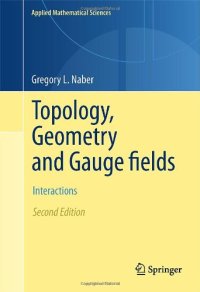
Ebook: Topology, Geometry and Gauge fields: Interactions
Author: Gregory L. Naber (auth.)
- Genre: Mathematics // Geometry and Topology
- Tags: Geometry, Theoretical Mathematical and Computational Physics, Combinatorics
- Series: Applied Mathematical Sciences 141
- Year: 2011
- Publisher: Springer-Verlag New York
- Edition: 2
- Language: English
- pdf
This volume is intended to carry on the program, initiated in Topology, Geometry, and Gauge Fields: Foundations (Springer, 2010), of exploring the interrelations between particle physics and topology that arise from their shared notion of a gauge field. The text begins with a synopsis of the geometrical background assumed of the reader (manifolds, Lie groups, bundles, connections, etc.). There follows a lengthy, and somewhat informal discussion of a number of the most basic of the classical gauge theories arising in physics, including classical electromagnetic theory and Dirac monopoles, the Klein-Gordon and Dirac equations and SU(2) Yang-Mills-Higgs theory. The real purpose here is to witness such things as spacetime manifolds, spinor structures, de Rham cohomology, and Chern classes arise of their own accord in meaningful physics. All of these are then developed rigorously in the remaining chapters. With the precise definitions in hand, one can, for example, fully identify magnetic charge and instanton number with the Chern numbers of the bundles on which the charge and instanton live, and uncover the obstruction to the existence of a spinor structure in the form of the second Stiefel-Whitney class. This second edition of the book includes, in an Appendix, a much expanded sketch of Seiberg-Witten gauge theory, including a brief discussion of its origins in physics and its implications for topology. To provide the reader with the opportunity to pause en route and join in the fun, there are 228 exercises, each an integral part of the development and each located at precisely the point at which it can be solved with optimal benefit.
Reviews of first edition:
“Naber’s goal is not to teach a sterile course on geometry and topology, but rather to enable us to see the subject in action, through gauge theory.” (SIAM Review)
“The presentation … is enriched by detailed discussions about the physical interpretations of connections, their curvatures and characteristic classes. I particularly enjoyed Chapter 2 where many fundamental physical examples are discussed at great length in a reader friendly fashion. No detail is left to the reader’s imagination or interpretation. I am not aware of another source where these very important examples and ideas are presented at a level accessible to beginners.” (Mathematical Reviews)
A study of topology and geometry, beginning with a comprehensible account of the extraordinary and rather mysterious impact of mathematical physics, and especially gauge theory, on the study of the geometry and topology of manifolds. The focus of the book is the Yang-Mills-Higgs field and some considerable effort is expended to make clear its origin and significance in physics. Much of the mathematics developed here to study these fields is standard, but the treatment always keeps one eye on the physics and sacrifices generality in favor of clarity. The author brings readers up the level of physics and mathematics needed to conclude with a brief discussion of the Seiberg-Witten invariants. A large number of exercises are included to encourage active participation on the part of the reader.